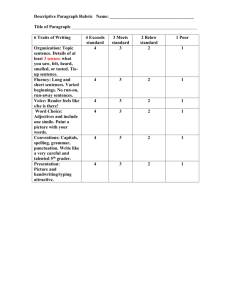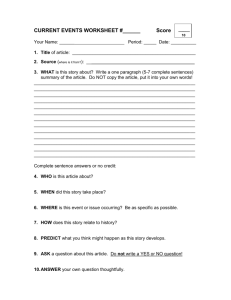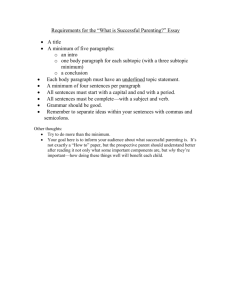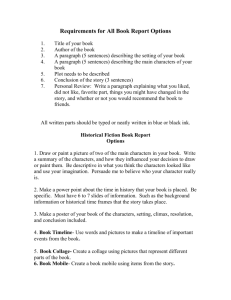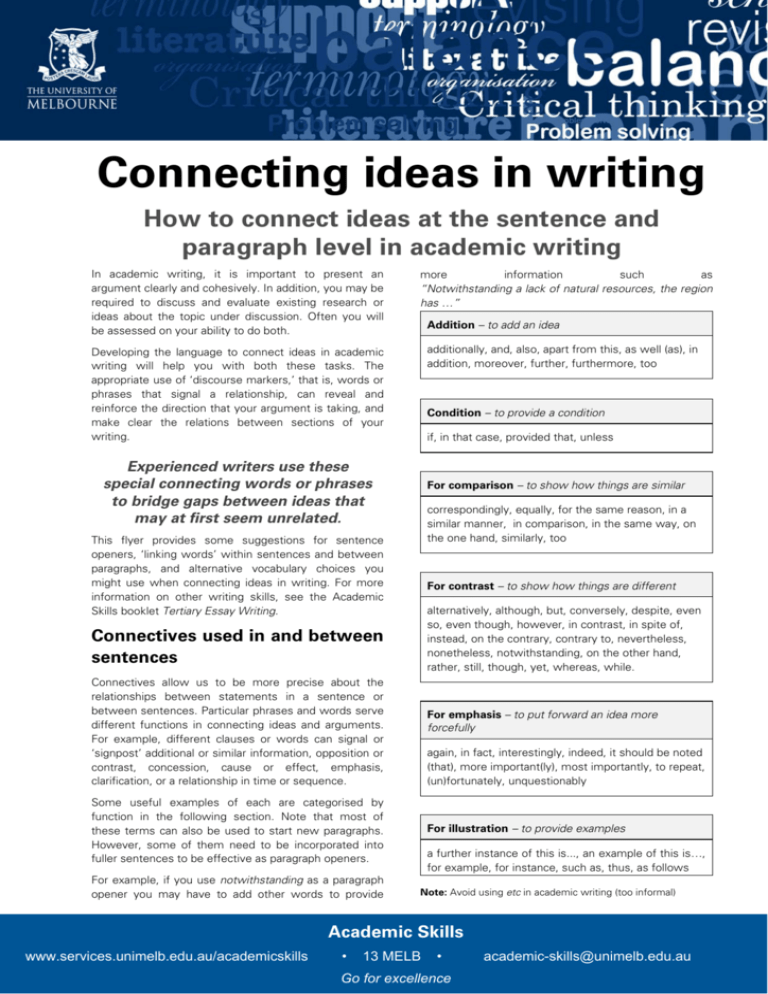
Connecting ideas in writing
How to connect ideas at the sentence and
paragraph level in academic writing
In academic writing, it is important to present an
argument clearly and cohesively. In addition, you may be
required to discuss and evaluate existing research or
ideas about the topic under discussion. Often you will
be assessed on your ability to do both.
more
information
such
as
“Notwithstanding a lack of natural resources, the region
has …”
Addition – to add an idea
additionally, and, also, apart from this, as well (as), in
addition, moreover, further, furthermore, too
Developing the language to connect ideas in academic
writing will help you with both these tasks. The
appropriate use of ‘discourse markers,’ that is, words or
phrases that signal a relationship, can reveal and
reinforce the direction that your argument is taking, and
make clear the relations between sections of your
writing.
Condition – to provide a condition
if, in that case, provided that, unless
Experienced writers use these
special connecting words or phrases
to bridge gaps between ideas that
may at first seem unrelated.
For comparison – to show how things are similar
correspondingly, equally, for the same reason, in a
similar manner, in comparison, in the same way, on
the one hand, similarly, too
This flyer provides some suggestions for sentence
openers, ‘linking words’ within sentences and between
paragraphs, and alternative vocabulary choices you
might use when connecting ideas in writing. For more
information on other writing skills, see the Academic
Skills booklet Tertiary Essay Writing.
For contrast – to show how things are different
alternatively, although, but, conversely, despite, even
so, even though, however, in contrast, in spite of,
instead, on the contrary, contrary to, nevertheless,
nonetheless, notwithstanding, on the other hand,
rather, still, though, yet, whereas, while.
Connectives used in and between
sentences
Connectives allow us to be more precise about the
relationships between statements in a sentence or
between sentences. Particular phrases and words serve
different functions in connecting ideas and arguments.
For example, different clauses or words can signal or
‘signpost’ additional or similar information, opposition or
contrast, concession, cause or effect, emphasis,
clarification, or a relationship in time or sequence.
For emphasis – to put forward an idea more
forcefully
again, in fact, interestingly, indeed, it should be noted
(that), more important(ly), most importantly, to repeat,
(un)fortunately, unquestionably
Some useful examples of each are categorised by
function in the following section. Note that most of
these terms can also be used to start new paragraphs.
However, some of them need to be incorporated into
fuller sentences to be effective as paragraph openers.
For example, if you use notwithstanding as a paragraph
opener you may have to add other words to provide
www.services.unimelb.edu.au/academicskills
For illustration – to provide examples
a further instance of this is..., an example of this is…,
for example, for instance, such as, thus, as follows
Note: Avoid using etc in academic writing (too informal)
Academic Skills
•
13 MELB
•
Go for excellence
academic-skills@unimelb.edu.au
Example (from beginning of previous paragraph):
For restatement – for rephrasing statements
One of the main advantages of X is . . .
in other words, more simply, namely, simply put, to
put it differently / another way, such as, that is
One of the positive effects of X is . . .
When you are ready to move your discussion to the
negative issues, you could write one of the following as
a paragraph opener:
The cause of things – to attribute the reasons for
something occurring
Example:
Having considered the positive effects of X, negative
issues may now need to be taken into account . . .
a / the consequence of, because, due to, for, the
effect of …, since, the result of …
Despite the positive effects outlined above, there are
also negative issues to be considered . . .
It is always important to make paragraphs part of a
coherent whole text; they must not be isolated units
unrelated to the whole piece.
The effect of things – to show the effect of
something
accordingly, as a result/consequence, consequently,
for this reason, hence, so, therefore, thus
’Do not expect your reader to make
the connection between your ideas,
but make those connections explicit.
This way, the reader will be lead in a
logical order through your argument
and will be reminded of your current
theme or angle.’
For concession / qualification – conceding
something
admittedly, although, clearly though, even though,
however, indeed, obviously
(Gillett, Hammond, & Martala, 2009)
Generalisation – making a general statement
Checking for paragraph links in your own work
When you are editing your next written assignment, ask
yourself the following questions as you read through
your work:
as a rule, for the most part, generally, in general, in
most cases, normally, on the whole, usually
Does the start of my paragraph give my reader
enough information about what the paragraph will
be about?
Does my paragraph add to or elaborate on a point
made previously and, if so, have I made this explicit
with an appropriate linking word / phrase?
Does my paragraph introduce a completely new
point or a different viewpoint to before and, if so,
have I explicitly shown this with a suitable
connective?
Have I used similar connectives repeatedly? (If yes,
may need to vary them using the above list.)
Time order – to indicate a chronological sequence
first, second, third (etc), next, before, earlier, finally,
following, given the above, later, meanwhile,
subsequently, then, to conclude, while
A note about punctuation & style
Check a usage guide for exact rules for punctuation.
Many introductory phrases have a comma after them.
For example, ‘Therefore,…‘ & ‘In addition,…‘ If in doubt,
read the sentence aloud and add commas when you
need to pause for breath. Also, several of the words
listed above are too informal for use in an academic
piece of writing – again, check a usage guide or good
dictionary for details of appropriate use.
Apart from using the linking words / phrases above,
showing the link between paragraphs could involve
writing ‘hand-holding’ sentences. These are sentences
that link back to the ideas of the previous paragraph. For
instance, when outlining the positive and negative
issues about a topic you could use the following:
www.services.unimelb.edu.au/academicskills
Works cited
Gillett, A. Hammond, A. & Martala, M. (2009). Successful
Academic Writing. Harlow, UK.: Pearson Longman.
Connecting paragraphs
Adapted from: Gillett, Hammond & Martala (2009)
Further resources
Gillet, A. Using English for Academic Purposes. Academic
Writing. Retrieved 2 Feb 2012 from
http://www.uefap.com/writing/writfram.htm
Academic Skills
•
13 MELB
•
Go for excellence
V1 1012 ST
academic-skills@unimelb.edu.au



